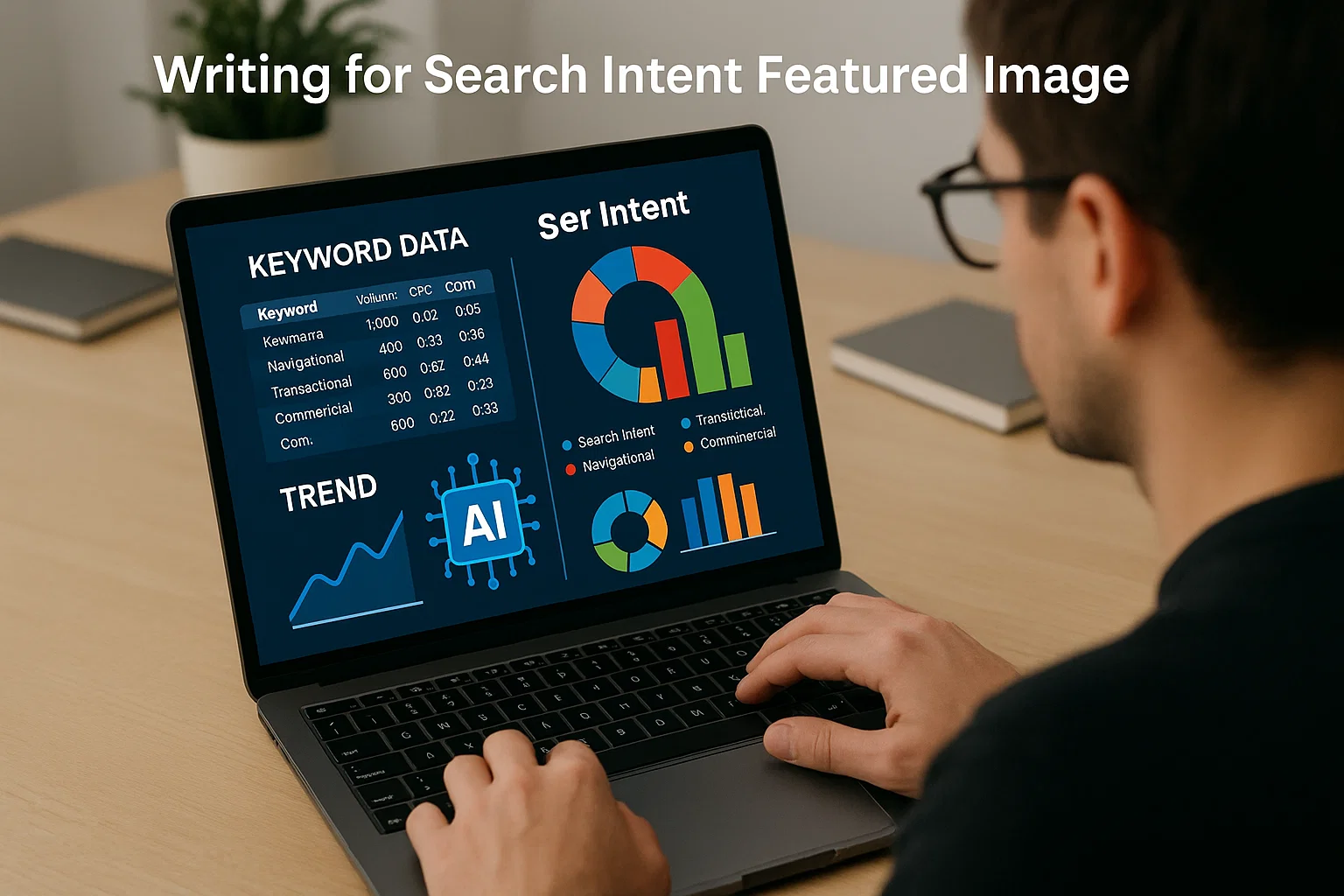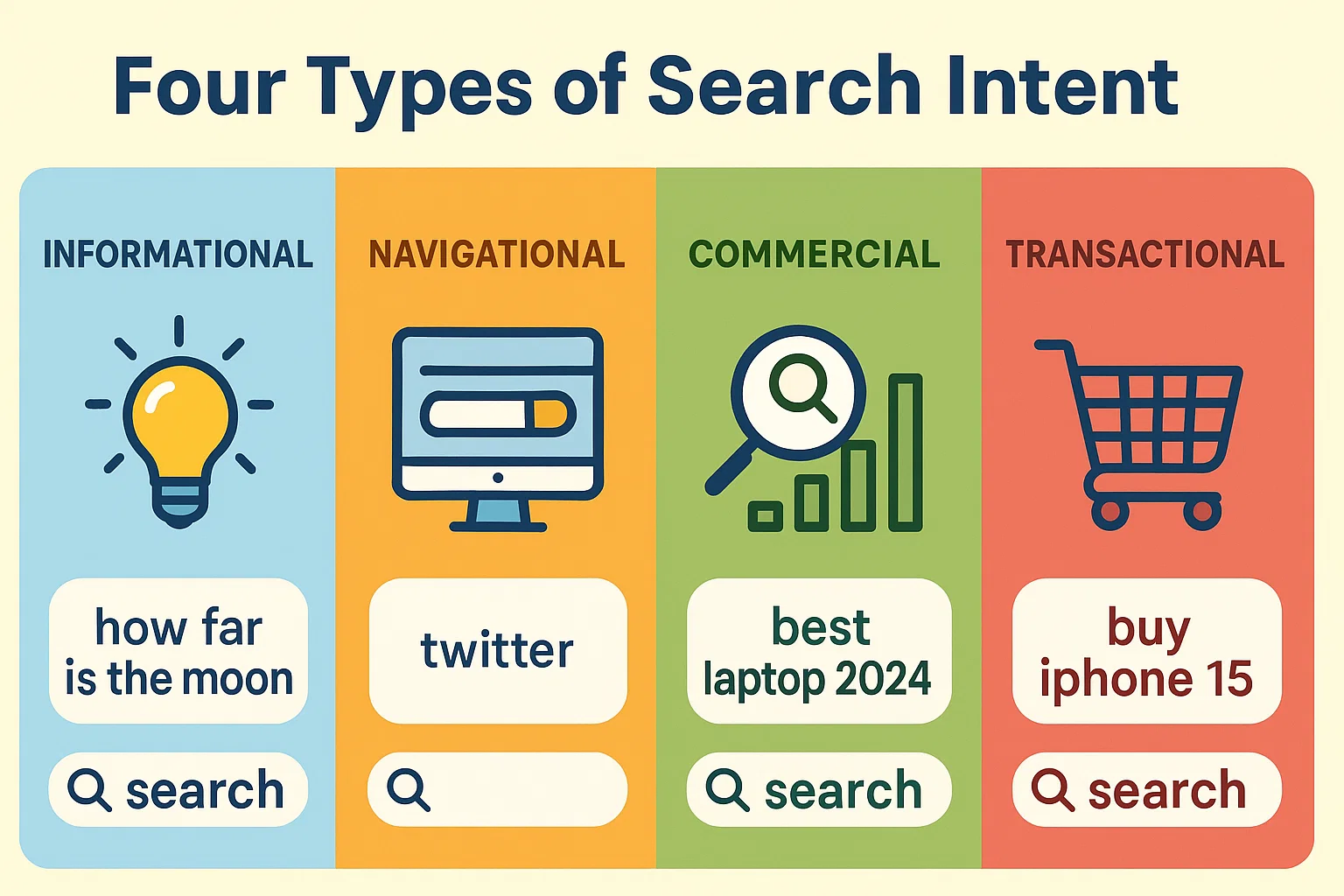Writing for search intent isn’t just about keywords anymore it’s about understanding why someone searches, what emotion drives that search, and how AI systems interpret it. Whether you’re crafting a blog post, sales page, or product review, the secret to ranking and retaining readers lies in one phrase: match the intent, not just the query.
Let’s break this down together from the psychology behind intent to the strategies that make both humans and algorithms love your writing.
Why Search Intent Shapes Every Click and Conversion
Imagine typing “best laptops 2025” into Google. You’re not just searching you’re deciding. You’re in a mental space between curiosity and action, comparing options before buying.
Now picture typing “how to fix slow laptop.” That’s a different mindset frustration and problem-solving, not purchasing.
That’s search intent at work.
Search intent is the underlying reason a person performs a search. It’s what connects the dots between your content and their expectation. When your writing aligns perfectly with that intent, magic happens readers stay longer, share your content, and Google takes notice.
“Search intent is the invisible bridge between search engines and human psychology.”
If you’ve ever wondered why some content ranks high even without many backlinks, it’s often because the intent match is spot-on. Google now rewards relevance and satisfaction, not just keywords.
When your content meets the reader’s intent:
- Bounce rates drop.
- Engagement rises.
- Trust builds.
- Conversion feels natural.
That’s the real SEO game.
The Four Types of Search Intent Explained
Every Google search, every ChatGPT prompt, every Bing Copilot query they all fall into four main intent types. Once you master these, you’ll never write aimlessly again.
Informational When Users Want to Learn
These are the “how,” “what,” “why,” and “who” searches.
Example:
- “What is content marketing?”
- “How does AI paraphrasing work?”
Your job here is to educate without overwhelming. Think guides, explainers, and blog posts that clarify complex things in plain English. Use headings, visuals, and friendly tone to keep them reading.
Tip: People searching informationally aren’t ready to buy yet but they’re forming trust. Be the teacher they remember.
Navigational When Users Want to Find
These searches happen when users already know where they want to go.
Example:
- “Spinbot login”
- “Grammarly plagiarism checker”
For writers, this means creating clear brand-focused or product-specific pages. If your audience is searching your name or tool, make sure your site ranks first otherwise, someone else will.
Tip: Keep navigational content clean, branded, and instantly recognizable.
Commercial Investigation When Users Compare
Here, people are researching before making a decision.
Example:
- “Jasper vs. ChatGPT”
- “Best AI writing tools for bloggers”
They want comparisons, pros and cons, reviews, and real data. This is where storytelling meets persuasion. Use side-by-side tables, personal testing, and genuine opinions.
Tip: Readers at this stage love honesty. Show both strengths and weaknesses that transparency builds credibility.
Transactional When Users Are Ready to Act
This is where intent turns into conversion.
Example:
- “Buy Grammarly premium”
- “Download SEO writing guide PDF”
Here, users already know what they want your job is to remove friction. Write direct, benefit-driven copy. Use strong CTAs (Call-to-Actions), emotional triggers, and proof.
Tip: Clarity beats cleverness. Don’t dance around the sale guide it confidently.
What Are the 3 C’s of Search Intent?
When Google’s John Mueller and SEO experts talk about intent, they often mention the 3 C’s Content Type, Content Format, and Content Angle.
These three define how your content should look, sound, and feel to match the reader’s needs.
- Content Type:
What kind of page fits the query?- Blog post, product page, landing page, video, or infographic?
Example: Searching “how to write a resume” = blog post or tutorial, not a sales page.
- Blog post, product page, landing page, video, or infographic?
- Content Format:
How is the information presented?- Listicle, step-by-step guide, case study, review, comparison?
Example: “Best laptops 2025” = comparison list, not an essay.
- Listicle, step-by-step guide, case study, review, comparison?
- Content Angle:
What’s the emotional or unique twist?- For beginners, experts, small businesses, quick tips, AI tools?
Example: “AI Writing Tools for Beginners” speaks differently than “AI Writing Tools for Enterprise Teams.”
- For beginners, experts, small businesses, quick tips, AI tools?
If your content doesn’t check all three boxes, it’s like showing up to the wrong classroom even if you studied the right subject.
Real-World Examples of Search Intent in Action
Let’s see how search intent changes everything.
| Search Query | Intent Type | Best Content Type | Goal of the User |
|---|---|---|---|
| “What is AI writing?” | Informational | Educational blog post | Understand basics |
| “Spinbot vs. Quillbot” | Commercial | Comparison review | Compare tools |
| “Spinbot free download” | Transactional | Landing page | Use tool |
| “Spinbot login” | Navigational | Homepage or portal | Access account |
Now imagine writing a 3,000-word tutorial for someone just searching “Spinbot login.” Total mismatch. They’d bounce in 3 seconds.
But give them a clear login button and short brand overview? You win their trust.
That’s why top-ranking pages mirror user goals, not just keyword volume.
How to Write for Each Type of Search Intent
So how do you make sure your writing always aligns with user intent even as AI-driven search changes everything?
Let’s break it down.
1. Matching Keywords to Reader Mindset
Every keyword has a mood behind it curiosity, confusion, decision-making, or urgency. Your headline and tone should reflect that.
| Intent | Mood | Tone Example |
|---|---|---|
| Informational | Curious | “Everything You Need to Know About…” |
| Navigational | Direct | “Visit Our Tool Dashboard Here” |
| Commercial | Evaluative | “Best Options Compared Side by Side” |
| Transactional | Ready | “Start Your Free Trial Now” |
Don’t just pick a keyword; pick a mindset.
2. Crafting Titles and Meta Tags That Reflect Intent
Your title tag is your first handshake with Google and readers. Make sure it clearly matches the user’s purpose.
- Informational: “What Is AI Writing? Simple Guide for Beginners”
- Commercial: “Top 5 AI Writing Tools Compared (2025 Edition)”
- Transactional: “Buy AI Writer Pro Save 50% This Week”
Your meta description should confirm the reader’s intent instantly. Add emotional hooks like “learn fast,” “trusted by professionals,” or “save time.”
3. Writing for AI Search (SGE, ChatGPT, and Beyond)
Welcome to the age where you’re not just writing for Google, but also for AI summarizers.
ChatGPT, Google’s SGE (Search Generative Experience), and Bing Copilot all summarize your content whether you like it or not.
So how do you write for both?
- Front-load the answer. Start with a direct, clear statement that answers the query.
- Add context. Follow with helpful examples and reasons why it matters.
- Structure logically. Use short paragraphs, bullet points, and headers.
- Write naturally. AI systems love conversational, human-like text.
- Include semantically related phrases. (e.g., “AI writing,” “content optimization,” “NLP tools”)
You’re not gaming the system you’re teaching it what your content is really about.
Pro Tip: Think like a teacher explaining something to a curious student, not like a robot stuffing keywords.
Using NLP and AI Tools to Decode Search Intent
AI doesn’t just help you write it helps you understand your audience on a deeper level.
Here’s how to use modern tools to uncover search intent signals before you even type the first word:
- Google SERP Analysis:
Type your keyword and note the top 5 results. Are they guides, tools, reviews, or stores? That’s your intent map. - Use Keyword Tools (SEMrush, Ahrefs, Ubersuggest):
These show intent labels and related questions people ask. Look at “People also ask” boxes they reveal hidden angles. - Leverage AI Writing Tools:
Tools like ChatGPT, Jasper, or Writesonic can analyze SERPs and summarize patterns.
Example prompt: “Summarize the top 5 intents behind the keyword ‘AI writing tools.’” - Analyze User Behavior:
Check dwell time, click-through rate (CTR), and bounce rate. If people leave fast, you’re probably mismatching intent. - Study NLP Entities:
Use tools like Google NLP or SurferSEO to identify entities (people, brands, concepts) that strengthen topical relevance.
AI + intuition = unstoppable SEO synergy.
Common Mistakes Writers Make (and How to Fix Them)
Even seasoned writers fall into intent traps. Here are the big ones to avoid:
- Writing for Keywords, Not People
- ❌ “How to content strategy SEO optimize 2025 tips”
- ✅ “How to Build a Winning Content Strategy in 2025”
Always write like a human first.
- Overeducating Buyers
When someone’s ready to buy, they don’t want a 10-minute lecture they want reassurance.
Tailor your content depth to intent. - Ignoring AI Search Results
If Google SGE shows an AI summary before your post, your opening paragraph must compete with that short, sharp, and satisfying. - Forgetting Emotional Intent
Behind every search, there’s emotion: curiosity, fear, excitement, confusion.
Speak to it. “Stop wasting hours writing here’s how AI can help.” - Using Generic CTAs
“Click here” or “Learn more” doesn’t cut it anymore. Use intent-matched CTAs:- “Compare tools now”
- “Start writing smarter today”
- “See real examples in action”
Writing That Wins Clicks and Trust
Let’s wrap this up not with a boring conclusion, but with real insight you can act on today.
- Search intent is the soul of SEO. Without it, your keywords mean nothing.
- The four intent types informational, navigational, commercial, transactional guide how users think.
- The 3 C’s of search intent (Type, Format, Angle) make or break your strategy.
- AI search is rewriting the rules. Write for clarity and conversation, not keyword stuffing.
- Great writing = empathy + data. Understand the reader’s goal, emotion, and journey.
When you write for intent, you’re not just optimizing for search engines you’re respecting your reader’s time and purpose.
That’s what separates forgettable content from content that converts, educates, and inspires.

AI writing strategist with hands-on NLP experience, Liam simplifies complex topics into bite-sized brilliance. Trusted by thousands for actionable, future-forward content you can rely on.



